Roke House
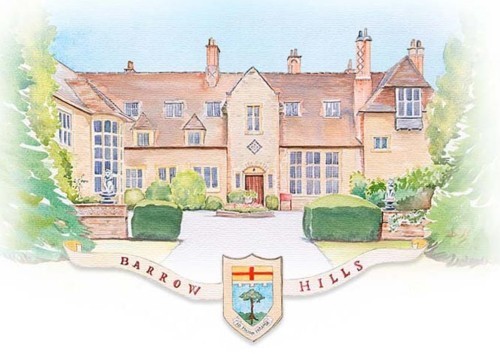
The history of St. Georges and Barrow Hills as schools has been well documented, and Mrs. LeFevre's
1969 centenary booklet covered the history of the Woburn estate before it became a school. However I am
not aware (but might be completely wrong) that anyone has researched the Great Roke estate at Witley
before it became a prep school for St. Georges in 1952.
Great Roke was built around 1909 - the date is set in the diamond decoration above the main door, although
construction must have taken more than one year. It is a substantial country house built in the style of a
tudor mansion. It was evidently designed for lavish entertaining, with numerous bedrooms and a large music
room with minstrels' gallery. A pipe organ (see below) occupied the large chamber in the music room that
in our time housed two side altars (now gone) to the right of the high altar, and this too must have been of
considerable size.
The architects were the Birmingham partnership
of Herbert Tudor Buckland (1869-1951)
and Edward Haywood-Farmer (?-1917), best known for their seminal Arts and Crafts houses
of which Great Roke was the largest and most ambitious. The general contractor was Henry Lovatt Ltd. of
Wolverhampton, with casement windows and heating from Henry Hope & Sons Ltd. of Birmingham. Fine
plasterwork on hall beams and in the music room was by Robert Catterson-Smith (1853-1938), also of
Birmingham, a forgotten Pre-Raphaelite and close associate of William Morris.
I spent some time recently researching the history of Roke House, mainly at Surrey Records Office in
Woking and internet searches of The Times and elsewhere. Here is what I found so far. Some time I will
visit the public record office in Birmingham to get more background on the Dixon family, where the wealth
came from that paid for it all, and how it was dissipated. Also I should visit Barrow Hills itself, which
must have some interesting records, if only the purchase deeds from 1952. The ownership and history of
Great Roke for the 25 year period from its sale in 1927 by the original owner until the Josephite
purchase in 1952 is a blank so far.
John Harvey, July 2009 (Barrow Hills boarder 1959-1963)
Witley
The village of Witley, near Godalming in Surrey, has a recorded history stretching back to the Domesday
book in 1086. The 1874 Ordnance Survey map shows Roke Farm just to the west of the village. The group of
farm buildings (just above the big "E" on the 1874 map) are still there today, past the chapel,
and will be remembered by old boys of our era as the bicycle shed, hockey stick room and Fr. Aidan's
workshop.
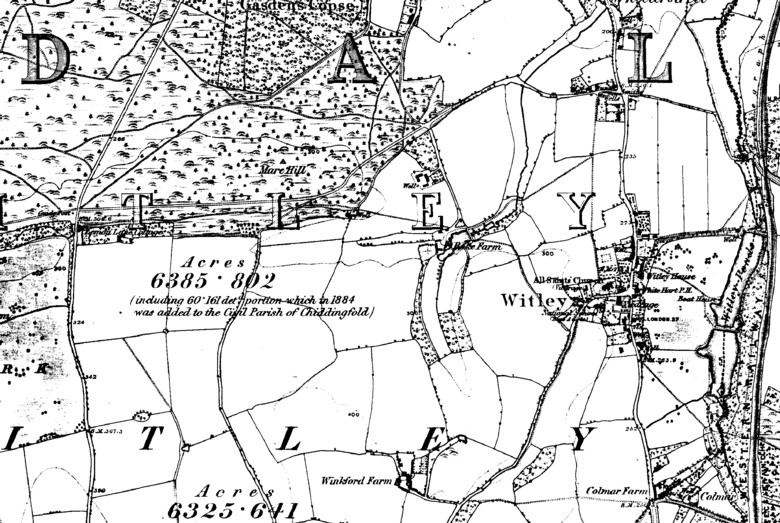
On a modern Ordnance Survey map the Barrow Hills buildings are just above "Witley".
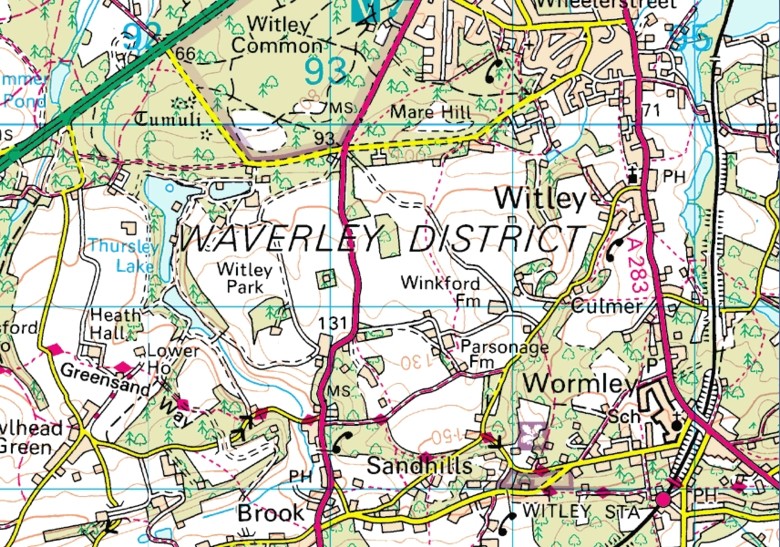
Charles Wolryche Dixon
Charles Dixon was the second son of George Dixon. He first appears in the 1909 electoral register for
Witley as a tenant, presumably while the house was being built. The 1910 and 1911 registers list his place
of abode as 12 Westbourne Road, Edgbaston, Birmingham. 1914 and 1915 registers list him at Great Roke.
Roke Farm was listed in the 1909 register, under a Mr. Palmer, but not subsequently.
The construction of Roke House attracted a considerable amount of attention in
the architectural press of the day.
Godalming Museum has a brief note on the design of the garden
by Gertrude Jekyll for Mrs. Dixon at Great Roke in 1910.
It also has a painting of Roke Farm by John Peel, a prolific late 19th century painter, showing a pond and cottage.
The 1911 census lists the following occupants of Roke House:
Charles Wolryche Dixon, born 1864
Agnes Margaret Dixon, born 1866 (wife)
James Dixon, born 1882 (relative)
John Wolryche Dixon, born 1892 (eldest son)
although Charles also had a daughter Christiana, and a younger son Roger.
Incidentally his uncle Abraham Dixon bought Cherkley Court near Leatherhead in the 1870s, a 400 acre
estate subsequently owned by Lord Beaverbrook.
I have little evidence so far about Charles Dixon's business affairs so far beyond the following.
The London Gazette (a Government journal of official record) of 24 May 1901 notes that he was a
partner in a Birmingham engineering business:
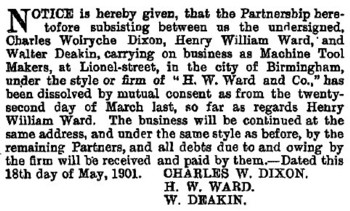
The London Gazette of 6 February 1912 records the dissolution of a business partnership. Perhaps
Charles, then aged about 48, was considering retirement from business, coincident with his relocation
from Birmingham to Surrey.
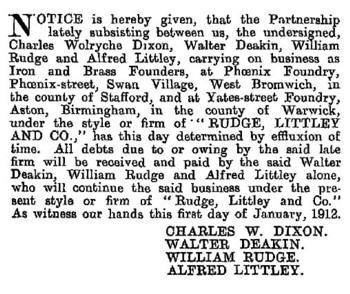
He was a Life Governor of Birmingham University, which was founded in 1900 (in practice this meant he
paid a large subscription of £1,000 or more to the founding fund). His wife was on the executive
committee of the women's hostel, and later is also listed as a Life Governor. In 1910 he is listed
as a Justice of the Peace (an unpaid lay magistrate).
Charles' first wife Agnes died in February 1918, and in 1924 he married Dorothy Murray Pringle.
Great Roke was put up for sale in 1924, only fifteen years after construction.
It was first advertised in The Times in March of that year.
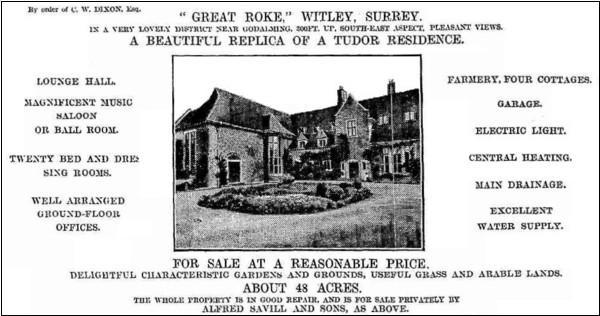
It was subsequently advertised repeatedly in The Times, sometimes with an asking price of £16,000,
before finally being sold three years later for £11,500 in early 1927.
The contents were auctioned separately shortly afterwards:
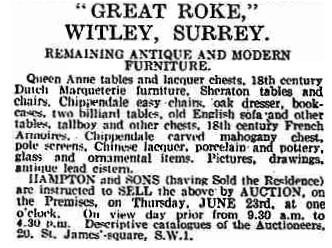
(Times, 17 May and 14 June 1927)
Charles Dixon died in 1945, aged 81. His second wife Dorothy survived him.

(Times, 7 May 1945)
Grayshurst (Highercombe Road, Haslemere, Surrey) was previously the home of Axel Haig, the Swedish
architect. A recent record shows that Grayshurst, was sold for £4.3 million in 2006. While still a
significant property, it is a fraction of the size of the Great Roke house and estate.
Auxiliary Home Hospital
During the First World War the Dixons placed Great Roke at the disposal of the British Red Cross
Society for use as an Auxiliary Home Hospital. Every auxiliary home hospital was attached to a central
military hospital, which directed the movements of the patients. (The Report of the Joint War
Committee of the British Red Cross Society and the Order of St John, HMSO 1921).
The Organ
The National Pipe Organ Register records
that the well-known organ builder firm of Norman & Beard of Norwich moved an organ
from Birmingham and re-erected it at Roke House in 1910, the contract price being £169.
In 1927 Hill, Norman & Beard (following the merger of Norman &
Beard with William Hill of London in 1916) moved the organ from Roke House to the residence of
B. Pardoe-Thomas of Newport, Monmouth (now Gwent). They lived in a very large house in
Newport called Pardoeham and ran a ship building business, Pardoe-Thomas and Co. Ltd.
of Newport.
Telephone
The long standing telephone number was still Wormley 34 in 1959, which must have been on a manual
local exchange. It subsequently became Wormley 2634 and then 0420 682634 with the introduction of
automated telephone exchanges and STD dialling. The school still has 01420 682634 as one of its
telephone numbers.
Origin of the "Barrow Hills" Name
Barrow Hills was the name of an estate at Longcross, near Virginia Water in Surrey. (A barrow is a
large mound of earth or stone placed over an ancient burial site). The house was built in 1853. For
many years it was the seat of
Lord
Camrose the newspaper proprietor. The 430 acre estate was put up for sale in 1936 after he
had purchased Hackwood Park, near Basingstoke, from Lord Bolton.
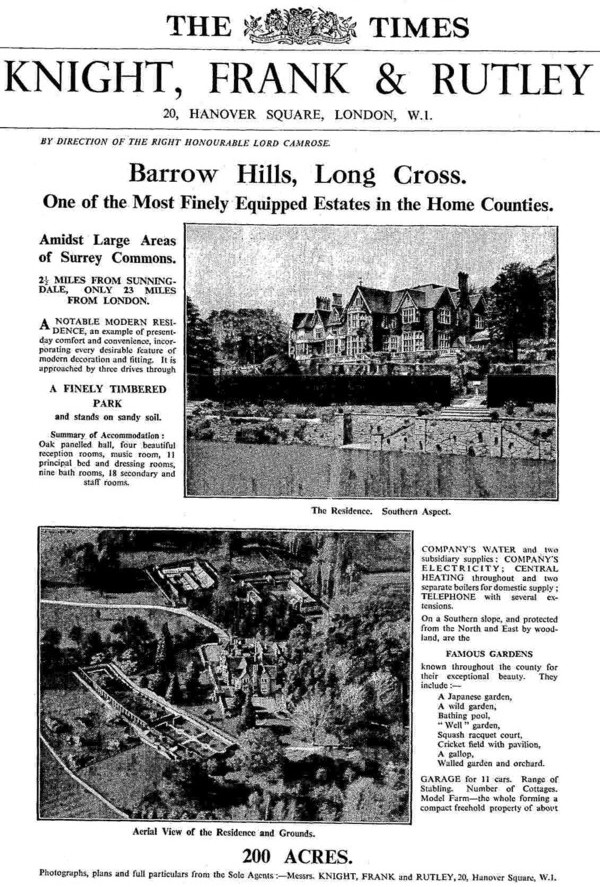
(Times, 5 November 1936)
In 1937 ownership passed to the British Greyhound Association who sold it in 1950 to St. George's College.
The following note appeared in The Daily Telegraph of 10th April:
Contracts for the sale of Barrow Hills, Longcross, near Chertsey, which is owned by the Greyhound Racing
Association, are expected to be signed within a month. Negotiator is St. George's College, Weybridge. When
the deal is completed, the house and 40 out of 212 acres will be taken over. If the Ministry of Town and
Country Planning gives its consent, it is to be converted into a boys' preparatory school accommodating
100 pupils. Opening is planned for September. Barrow Hills was for many years the seat of Viscount Camrose.
Sir John Mullens was a former owner. He brought Japanese gardeners specially from the East to lay out the
water garden. Among other amenities in the grounds is a squash court.
Hence in 1950 a new and separate boarding and day school for the younger pupils of St George's
College was established at Barrow Hills, Longcross, which was conveniently not far from Weybridge.
Shortly afterwards the Government decided that a proposed fighting vehicle test area at Chobham
should be extended to the west at Barrow Hills:
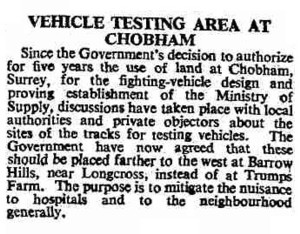
(Times, 19 May 1951)
Barrows Hills was consequently compulsory purchased by the Ministry of Works so that tanks could be
tested on the large, rambling site:

(Times, 5 January 1952)
In May 1952, the boarders moved to their new 40-acre site at Witley near Godalming and took the name
Barrow Hills with them. The dayboys returned back to Woburn Park where they occupied the cottage
adjacent to Woburn Hill, hence the name Woburn Hill School. The house became an Officers' Mess and
subsequently a test track was built in the grounds, destroying much of the Japanese Garden. The house
was
Grade II listed in 1999.
Subsequent history of the original Barrow Hills at Longcross
For over 60 years since its acquisition by the Ministry of Defence this 300 acre site had been used
to test and evaluate world famous tanks such as the Challenger, Chieftain and Scorpion. Over the
decades since WWII, it was designated as the Fighting Vehicles Research and Development Establishment
(FVRDE), the Military Vehicles Engineering Establishment (MVEE) and a branch of the Royal Armament
Research and Development Establishment (RARDE), before finally being incorporated into DERA. In more
recent years, under QinetiQ, unmanned ground vehicles were developed here, as well as robot mine
sweepers.
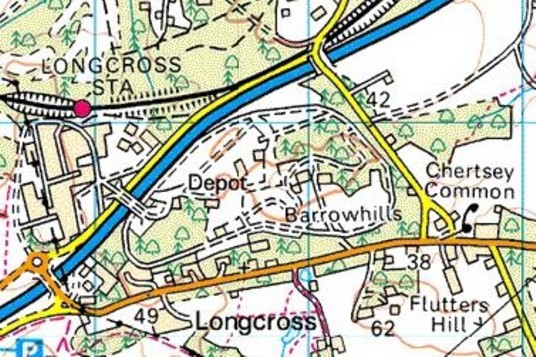
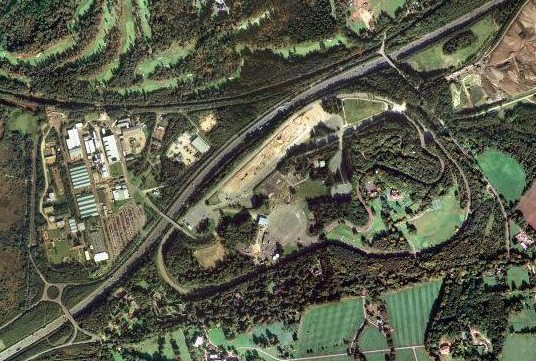
The test track was three miles long, with various challenging chicanes and negative camber features.
At the centre of the track loop, you can spot the Grade II listed mansion house, Barrowhills, complete
with a small golf course. The mansion once housed the officers' mess for the military personnel at
the north site.
It was announced in 2004 that, following over three years of intense negotiations between QinetiQ and
a property development consortium, the whole site was to be sold off, ending over 60 years of military
vehicle testing. The 100 acre north site was earmarked as a million square feet of office space, while
the test track site to the south was to be luxury housing with shopping facilities and a community
centre.
Longcross Film Studios
In 2004 the house was purchased by a consortium headed by Crest Nicholson plc. and
Longcross Film Studios was established
in 2006. The house has since been used for a number of well known film and TV dramas. Sam Mendes, the
director of the James Bond movie Skyfall, filmed the Scottish house scenes at Longcross on cold winter
nights so the actors' breath would "steam" convincingly, Judi Dench and Daniel Craig shivering
their way through the takes. It is currently being used as Nonnatus House in the BBC television series
Call The Midwife, series 4 onwards.
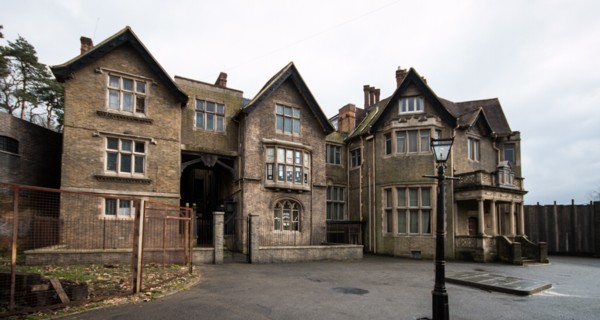
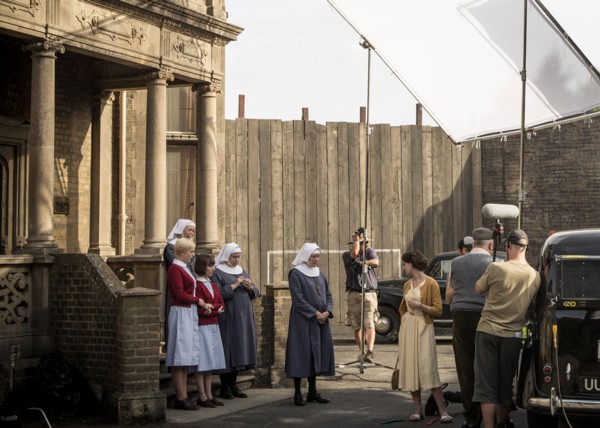
More pictures
Here. See this YouTube clip
for a short walkround outside and inside the set.